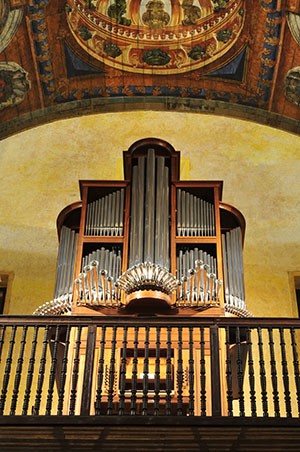 Friday, 09 October, 9.30 p.m.
Friday, 09 October, 9.30 p.m.
Church of São João Evangelista (Colégio)
"Critical Mass is defined as 'the smallest amount of fissionable material sufficient to sustain a chain reaction'. It seemed an appropriate title for this brief but energetic piece." This comment by James Moberley, though originating in the latent ambiguity of the word “Mass”, perfectly reflects the general philosophy of today's programme: at a crossroads of musical styles and periods, paths both familiar and unknown are explored through apparently fortuitous connections. However, on this surprising journey beyond time and boundaries, cohesion will become apparent little by little through the recurrence of styles, melodies and musical forms. From Suzanne van Soldt and her jeune fillette to the Fantasy by Bert Matter, which uses the same motive, from the passacaglias by Buxtehude and Raison to the monument by Johann Sebastian Bach, which is introduced by them, from Johann Caspar Kerll's “cuckoo” to Jon Laukvik's MM, from baroque offices (François Couperin) to the “offices” of the 20th century (Jehan Alain) from one work with tape to another, from one baroque dance that appears here to another that reappears there, the bridges are numerous. The linked atmospheres will create a process of construction culminating in the masterly peroration that is Bach's Passacaglia. Like the builders of cathedrals, composers never ceased to build the history of music, the heritage of humanity. Each one brought his stone to the building, each one worked for the art, each one worked for “his” truth. Let us move among these multiple steps, profoundly human, profoundly “true”.
Olivier Latry
Anónimo (manuscript of Suzanne Van Soldt, 1599)
Four Flemish Dances
I. Allemande Loreyne
II. Almande Brun Smeedelyn
III. Almande de La nonette
IV. Almande de symmerman
Dieterich Buxtehude (1637-1707)
Passacaglia in D minor
Johann Caspar Kerll (1627-1693)
Cappricio cucu
Jon Laukvik (n.1952)
MM (for organ and electronics)
André Raison (c.1640-1719)
Trio en passacaille (Messe du 2° ton)
François Couperin
Offertoire sur les grands jeux (Messe des Paroisses)
James Mobberley (n.1954)
Critical Mass (para órgão e electrónica)
Jehan Alain (1911-1940)
Postlude pour l’office des complies
Bert Matter (n. 1937)
Fantasia sobre Une jeune fillette
Johann Sebastian Bach (1685-1750)
Passacaglia and Fugue in C minor
Olivier Latry (n.1961)
Improvisation on a theme given by the audience
Participants
|
Olivier Latry is titular organist of the Cathedral of Notre-Dame in Paris and professor of organ at the Higher National Conservatory of Music in the same city. His nomination to the first cathedral in France in 1985, at the age of 23, propelled him the centre of the international stage. He has performed in more than fifty countries on five continents, in recital and with orchestra. Amongst his extensive discography are the complete organ works of Olivier Messiaen, recorded for Deutsche Grammophon, and the Poulenc Concerto and Symphony no. 3 by Saint-Saëns with the Philadelphia Orchestra under Christoph Eschenbach. A recipient of the Cino and Simone del Duca Prize in 2000, he was also made, in the United Kingdom, an Honorary Member of the North and Midlands School of Music in 2006, and of the Royal College of Organists in 2007. he was nominated “International performer of the year” by the American Guild of Organists in New York in 2009. In June 2010, the McGill University of Montreal awarded him the degree of Doctor Honoris Causa. In December 2012 he was named organist emeritus of the Montreal Symphony Orchestra. |
Notes about the Organ
 Church of São João Evangelista (Colégio), Funchal
Church of São João Evangelista (Colégio), Funchal
This instrument, with 1586 sounding pipes, is situated in a religious space with certain particularities. As a church typical of those belonging to Jesuit colleges, with a broad nave and quite a gentle acoustic, the organ had to be specially conceived, especially with regard to the measurements of the pipes. Thus all the pipework of the instrument has been specifically tailored to produce a full sound, and each stop produces a timbre with an individual personality, forming part of a harmonic ensemble based more on the sound of fundamentals and less on harmonics. It was also felt to be essential to give the instrument a certain ‘latin’ sonority that would favour performance of ancient music of the Italian, Spanish and Portuguese schools of the 17th and 18th centuries.
Another aspect to be taken into consideration was the need to complement the current range of organs available locally: the new organ responds in an ideal fashion to the performance of works of periods and of technical and artistic requirements that none of the 24 historic instruments of Madeira cater adequately for. It also enhances the range of organs that constitute the island’s heritage by being present in this particular religious space, as well as by existing side by side with other historical instruments. In the decision to build it for this church, not only were the issues of acoustic, aesthetic and liturgical space taken into account, but also the presence there of an important historic instrument which is currently on the list of instruments undergoing restoration.
I Manual - Órgão Principal (C-g’’’)
Flautado aberto de 12 palmos (8’)
Flautado tapado de 12 palmos (8’)
Oitava real (4’)
Tapado de 6 palmos (4’)
Quinzena (2’)
Dezanovena e 22ª
Mistura III
Corneta IV
Trompa de batalha* (bass)
Clarim* (treble)
Fagote* (bass)
Clarineta* (treble)
II Manual - Órgão Positivo (C-g’’’)
Flautado aberto de 12 palmos (8’)
Tapado de 12 palmos (8’)
Flautado aberto de 6 palmos (4’)
Dozena (2 2/3’)
Quinzena (2’)
Dezassetena (1 3/5’)
Dezanovena (1 1/3)
Címbala III
Trompa real (8’)
Pedal (C-f’)
Tapado de 24 palmos (16’)
Bordão de 12 palmos (8’)
Flautado de 6 palmos (4’)
Contrafagote de 24 palmos (16’)
Trompa de 12 palmos (8’)
Couplers
II/I
I/Pedal
II/Pedal
* horizontal reeds
 Olivier Latry
Olivier Latry